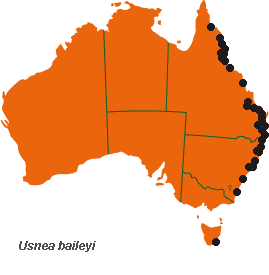



Australian Biological Resources Study
| Checklist of the Lichens of Australia and its Island Territories | ||
| Introduction | A–D | E–O | P–R | S–Z | Oceanic Islands | References | ||
| Usnea baileyi (Stirt.) Zahlbr. | ||
| Denkschr. Kaiserl. Akad. Wiss., Math.-Naturwiss. Kl. 83: 182 (1909); Eumitria baileyi Stirt., Scott. Naturalist (Perth) 6: 100 (1881). T: near Brisbane, Qld, F.M.Bailey 164; lecto: BM, fide R.W.Rogers, Austrobaileya 1: 503 (1982). ****Eumitria implicita Stirt., Scott. Naturalist (Perth)6: 100 (1881); Usnea implicita (Stirt.) Zahlbr., Cat. Lich. Univ. 6: 582 (1930). T: Funchal, Madeira, J.Payne s.n.; lecto: BM, fide R.W.Rogers & G.N.Stevens, Austral. Syst. Bot. 1: 357 (1988). ****Usnea barbata var. asperrima Müll.Arg., Flora 65: 299 (1882); U. percava f. asperrima (Müll.Arg.) J.Steiner, Verh. K.K. Zool.-Bot. Ges. Wien, B, 53: 231 (1903); Eumitria asperrima (Müll.Arg.) Vain., Ann. Acad. Sci. Fenn., ser. A, 6(7): 10 (1915). T: Illawarra, N.S.W., W.Kirton; holo: G; iso: MEL. ****Usnea barbata var. tasmanica Müll.Arg., Flora 65: 299 (1882); Eumitria tasmanica (Müll.Arg.) Vain., Ann. Acad. Sci. Fenn., Ser. A, 6(7): 10 (1915); Usnea tasmanica (Müll.Arg.) Zahlbr., Cat. Lich. Univ. 6: 594 (1930). T: Van Diemens Land [Tas.], 1878, de Franquer 31; holo: G. ****Eumitria formosa Stirt., Scott. Naturalist (Perth)6: 297 (1883); Usnea formosa (Stirt.) Zahlbr., Cat. Lich. Univ. 6: 575 (1930). T: Peak Ra., Qld, Statter s.n.;lecto:BM, fide R.W.Rogers, Austrobaileya 1: 503 (1982). ****Usnea barbata var. substrigosa Müll.Arg., Flora 72: 143 (1889); U. dasypogoides var. substrigosa (Müll.Arg.) Zahlbr., Cat. Lich. Univ. 6: 652 (1930). T: Clarence R., N.S.W., J.Wilcox; holo: G; iso: MEL. ****Usnea eizanensis Asahina, Lichens Japan III. Genus Usnea 42 (1956). T: District Mt Hiyei (eastern side), Prov. Omi, Japan, coll. unknown; holo: TNS. ****[Usnea poliotrix auct. non Kremp.: W.W.Watts, Proc. Linn. Soc. New South Wales, ser. 2, 28: 498–499 (1903)]. | ||
| Thallus erect to subpendulous, 5–15 (–20) cm long, grey to greenish grey; branching subdichotomous to irregular; trunk usually black, rarely pale; branches terete or somewhat ridged, 1.0–1.5 mm wide; apices attenuate, straight or arcuate; fibrils sparse to dense on main branches, to 5 mm long. Isidia sparse to dense, solitary or clustered, papilla-like when immature, becoming cylindrical and easily dislodged, eroding to leave pseudocyphellae; pseudocyphellae punctiform, scattered; soralia absent. Cortex cracked, matt. Medulla dense, with a yellow, pink, red-brown, maroon or chocolate-brown layer around axis; axis hollow, 3/4 width of branch. Apothecia rare, terminal on short lateral branches; disc plane; margin and lower surface bearing fibrils. Ascospores 8–10 × 5–6 µm. CHEMISTRY: Cortex containing usnic acid. Medulla K+ red (difficult to see because of the pigment); containing eumitrin A, ±eumitrin B, norstictic acid (major), ±salazinic acid (minor or trace), connorstictic acid (trace), galbinic acid (trace) and hyposalazinic acid (trace); zeorin and secalonic acid A may also be present. |  |
|
| Common in open forest, on the branches in rainforest canopies, on fence posts and on rock in Qld and N.S.W.; rare in Tas. Also in Lord Howe Is. and known from other tropical and warm-temperate regions of the world. | ||
| Stevens (2004) | ||
| Checklist Index |
| Introduction | A–D | E–O | P–R | S–Z | Oceanic Islands | References |
This work is copyright. Apart from any use as permitted under the Copyright Act 1968, no part may be reproduced by any process without prior written permission from Australian Biological Resources Study. Requests and inquiries concerning reproduction and rights should be addressed in the first instance to Dr P. McCarthy. These pages may not be displayed on, or downloaded to, any other server without the express permission of ABRS.